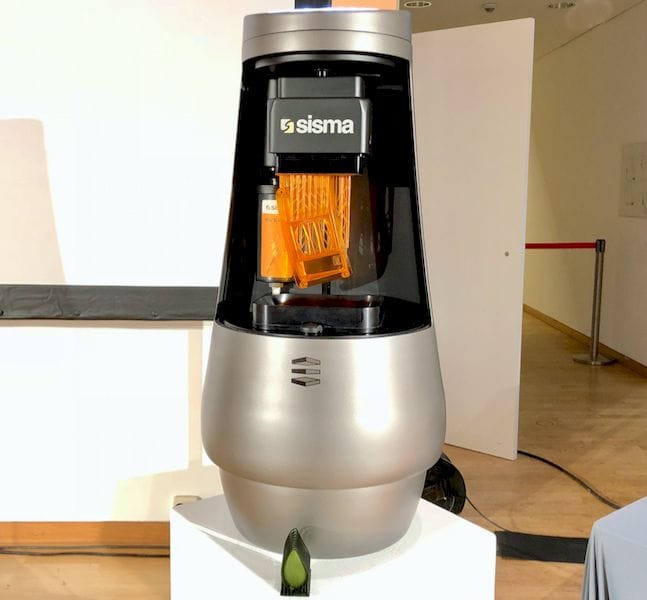![The Everes series 3D printers from Sisma [Source: Fabbaloo]](https://fabbaloo.com/wp-content/uploads/2020/05/image-asset_img_5eb0a1500c29f.jpg)
We attended an announcement of two new resin 3D printers from Sisma.
The Italian company has been in operation since 1961, primarily making manufacturing machines for chain production. But more recently they’ve delved into 3D printing, beginning with a metal 3D printer and an initial SLA device in 2016. Now they’re getting deeper into the resin business, with the Everes series.
The new machines, the Everes Uno and Everes Zero, both use the SLA process in which a DLP UV source selectively solidifies a liquid photopolymer resin layer by layer. They’re targeted at the dental, jewelry and prototyping industries.
![A sample jewelry 3D print from Sisma’s Everes equipment [Source: Fabbaloo]](https://fabbaloo.com/wp-content/uploads/2020/05/image-asset_img_5eb0a1506eacf.jpg)
The machines use a new form of resin 3D printing the company calls “ZTT” (Zero Tilting Technology). They’re trying to overcome one of the fundamental limitations of the SLA process: speed constrained by layer motion.
![Large solid parts produced on Sisma’s Everes 3D printers [Source: Fabbaloo]](https://fabbaloo.com/wp-content/uploads/2020/05/image-asset_img_5eb0a150bf506.jpg)
In a typical SLA setup, a fresh layer is created by shining a light source through a transparent tank bottom. The new layer is solidified, but also tends to adhere to the bottom of the tank. To detach it the machine must perform a very slow “peel” process in which the system is tilted gradually. This does peel the layer off the bottom, but also slows down printing considerably.
A few other vendors have developed workarounds of one type or another to gain significant speed advantages. It seems that Sisma has found yet another way to do this with ZTT.
How does ZTT work? It was a bit confusing to us at first, but we finally think we’ve figured out what they’re doing. The key seems to be a special tray that includes a slightly flexible 125 micron teflon sheet.
![The ZTT two-layer system’s teflon tray on Sisma’s Everes 3D printers [Source: Fabbaloo]](https://fabbaloo.com/wp-content/uploads/2020/05/image-asset_img_5eb0a1511396c.jpg)
The sheet, shown here, is where the liquid photopolymer is deposited. The light source shines through the bottom. But underneath the floppy teflon sheet is a solid, flat glass platform. This glass is what tips. When the glass is pressed against the teflon sheet, it becomes rigid and suitable for printing. But when not in contact the teflon sheet flexes and easily releases the fresh print layer. There’s two layers involved in 3D printing here.
We’re told that the glass automatically aligns correctly when pressed into the flexible sheet, likely by means of rigid side rails. This removes any requirement for manual calibration on the machine.
![This 3D print was done in around 2 hours on a Sisma Everes 3D printer [Source: Fabbaloo]](https://fabbaloo.com/wp-content/uploads/2020/05/image-asset_img_5eb0a1517520b.jpg)
This allows the Everes machines to 3D print at a very rapid rate. Sisma says the print rate maxes out at 6 minutes per 10mm. The above print, which actually is a part for the machine itself, and is around 200mm tall, was apparently 3D printed completely in only two hours. That’s pretty fast!
![Very delicate 3D prints are possible on the Sisma Everes equipment [Source: Fabbaloo]](https://fabbaloo.com/wp-content/uploads/2020/05/image-asset_img_5eb0a151c47e4.jpg)
There is another implication: “Peeling” machines necessarily must apply some force to the 3D model, and often you may find that delicate structures are broken during this process. Because of ZTT, this means that Everes prints can be far more delicate and less attention needs to be paid to succeed with such 3D models.
The tray is reusable, at least for identical materials, and apparently does not degenerate. We were not able to get a straight answer from the company as to whether a tray could be reused with a different material. For food-safe materials, this is quite important.
![Leftover photopolymer resin in a Sisma Everes 3D printer [Source: Fabbaloo]](https://fabbaloo.com/wp-content/uploads/2020/05/image-asset_img_5eb0a15217060.jpg)
One curious aspect that we cannot figure out is the disposition of leftover resin. We were led to believe that the unused resin is somehow put back into the cartridge for future use without operator intervention. How they do this is unclear. If this is so, then it removes one source of mess that’s often seen in resin 3D printers: mistakes made when manually pouring resin.
Prints can be made in the print volume of either 96 x 54 x 200 mm or 125 x 70 x 200 mm, depending on which machine you’re using. The Everes Zero has the smaller print volume, but the voxels are smaller at only 0.05mm. The Everes Uno has a larger print volume, but the print voxels are a bit larger at 0.065mm.
![A proprietary resin cartridge for the Sisma Everes 3D printers [Source: Fabbaloo]](https://fabbaloo.com/wp-content/uploads/2020/05/image-asset_img_5eb0a1525a2c1.jpg)
The current five materials for the Everes machines are proprietary and are apparently priced at the very high price of US$140 per half liter, or US$280 per liter. This is one of the highest-cost resins we’ve seen, and is perhaps the biggest disappointment we have with the Everes machines, especially after Carbon lowered their resin price to only US$50 per liter.
![A 3D print made by Sisma showing their “self hiding resin” [Source: Fabbaloo]](https://fabbaloo.com/wp-content/uploads/2020/05/image-asset_img_5eb0a152a7597.jpg)
One interesting resin being shown by Sisma is a “self hiding resin”. Apparently this resin includes glass particles the same size as the resolution of the machine. This makes the printed objects have a different appearance, but it’s unclear to us how this could be best used.
The new machines are priced identically at €13,900 each (US$15,800).
Via Sisma











FELIXprinters has released a new bioprinter, the FELIX BIOprinter, which is quite a change for the long-time 3D printer manufacturer.